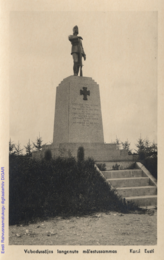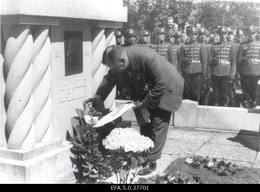Julius Kuperjanovas (1894–1919)
I WW1, I Nepriklausomybės karai
Estijos karininkas, vadas ir Nepriklausomybės kovų didvyris. Laisvės kryžiaus 1-ojo laipsnio 2-ojo laipsnio ir 2-ojo laipsnio 3-iojo laipsnio gavėjas (po mirties).
Julius Kuperjanovas gimė 1894 m. spalio 11 d. estų emigrantų šeimoje, gyvenančioje Pskovo gubernijoje. 1904 m. šeima grįžo į Estiją ir apsigyveno Tartu apskrityje.
Kuperjanovas buvo pašauktas į kariuomenę Pirmojo pasaulinio karo metais 1915 m. Rusijos imperatoriškosios armijos. Jis mokėsi 4-ojoje Vladimiro karo mokykloje Sankt Peterburge. Vėlesnėje karinėje tarnyboje jis pasižymėjo drąsa ir gavo septynis Rusijos karinius apdovanojimus. 1917 m. liepą jis buvo sužeistas ir evakuotas į Maskvą.
1916 m. lapkritį Kuperjanovas buvo paaukštintas iki leitenanto laipsnio. 1917 m. lapkritį jis buvo perkeltas į Tartu tarnauti jaunesniuoju karininku ir kuopos vadu Estijos papildymo batalione. Gruodį jis buvo paaukštintas iki bataliono vado padėjėjo.
Vokiečiams okupavus Estiją, Estijos armija buvo išformuota, o personalas atleistas. 1918 m., vokiečių okupacijos metu, Kuperjanovas slapta organizavo pogrindinius namų apsaugos būrius, kurie vėliau tapo Gynybos lygos įkūrimo pagrindu.
Prasidėjus Nepriklausomybės karui, Kuperjanovas buvo paskirtas Tartu apskrities Gynybos lygos regiono vadu. Užėmus Tartu miestą, Estijos pajėgos pasitraukė į Puurmani dvarą. Ten, per 1918 m. Kalėdas, jis iš savanorių vyresniųjų mokinių ir Gynybos lygos narių suformavo karinį dalinį – vadinamąjį jo vardu pavadintą Kuperjanovo partizanų batalioną, kuris sulaukė didelio populiarumo.
Jo karinis dalinys pirmasis puolė išlaisvinant Tartu 1919 m. sausio 14 d., įsiverždamas šarvuotais traukiniais. Toliau žygiavo Valgos link. Kuperjanovas buvo sunkiai sužeistas Paju mūšyje netoli Valgos sausio 31 d. ir žuvo 1919 m. vasario 2 d. Tartu. Estijos ginkluotųjų pajėgų vyriausiasis vadas generolas Johanas Laidoneris oficialiai pavadino batalioną pirmojo leitenanto Kuperjanovo partizanų batalionu žuvusio vado garbei. Šiandien vienas iš Estijos sausumos pajėgų karinių dalinių vadinasi Kuperjanovo pėstininkų batalionas.
Alisa (mergautinė pavardė Johanson), Juliaus Kuperjanovo žmona, buvo viena iš Moterų savanoriškos gynybos organizacijos įkūrėjų ir rėmėjų. Ji buvo deportuota 1941 m. ir sušaudyta 1942 m. Sovietų Sąjungoje.
Susijusios vietos
Nepriklausomybės karo paminklas Puurmanyje
Šis paminklas yra netoli nedidelio Puurmanio miestelio, prie Puurmanio ir Tabiverės kelio.
Skulptūrą, kurią suprojektavo Voldemaras Mellikas, 1926 m. rugsėjo 26 d. atidengė Kuperjanovo partizanas, gulintis ant granito postamento ant savo šautuvo. Bronzinė statula dingo sovietmečiu. Postamentas buvo susprogdintas, o kalva, ant kurios ji stovėjo, sulyginta 1948 m. Vietoj jos buvo pastatytas Raudonosios armijos paminklas, kuris 1970 m. buvo pakeistas Didžiojo Tėvynės karo paminklu. Kadri Metsik sukurta restauruota originalaus paminklo versija buvo iš naujo atidengta 1992 m. birželio 23 d. Aplink paminklą pasodintas naujas parkas, kurio medžiai pavadinti Nepriklausomybės kare žuvusių ir kitų žymių Kursų parapijos asmenybių vardais.
Šaltiniai:
Nacionalinės paveldo tarybos kultūros paminklų registras. https://register.muinas.ee/public.php?menuID=monument&action=view&id=27111
leitenanto Juliaus Kuperjanovo kapas
Šis paminklas yra Raadi kapinėse Tartu mieste, kairėje nuo pagrindinio tako, atkarpoje netoli Kruusamäe gatvės.
Nepriklausomybės kovų didvyrio leitenanto Juliaus Kuperjanovo antkapinis paminklas buvo suprojektuotas garsaus estų skulptoriaus Jaano Koorto ir atidengtas 1925 m. spalio 11 d. Sovietmečiu bronzinis žemas reljefas ir ant paminklo esantys tekstai buvo pašalinti. Pats antkapis nebuvo nugriautas ir tapo pasipriešinimo užsienio režimui simboliu, ant kurio slapta buvo dedamos gėlės ir žvakės. Paminklas buvo atkurtas į pirminę būklę.
Susijusi istorija
Cėsių mūšio pradžia, eiga ir pabaiga
Pergalė Cėsių mūšyje turėjo tapti lūžio tašku Latvijos ir Estijos kovoje už savo šalies nepriklausomybę. Ši pergalė sustabdė Andrijevo Niedros vyriausybės ir vokiečių generolo Rüdigerio fon der Golco planus užkariauti Pabaltijį. Vietoj to, Liepojoje savo veiklą atnaujino Karlio Ulmanio vadovaujama Laikinoji Latvijos vyriausybė.








